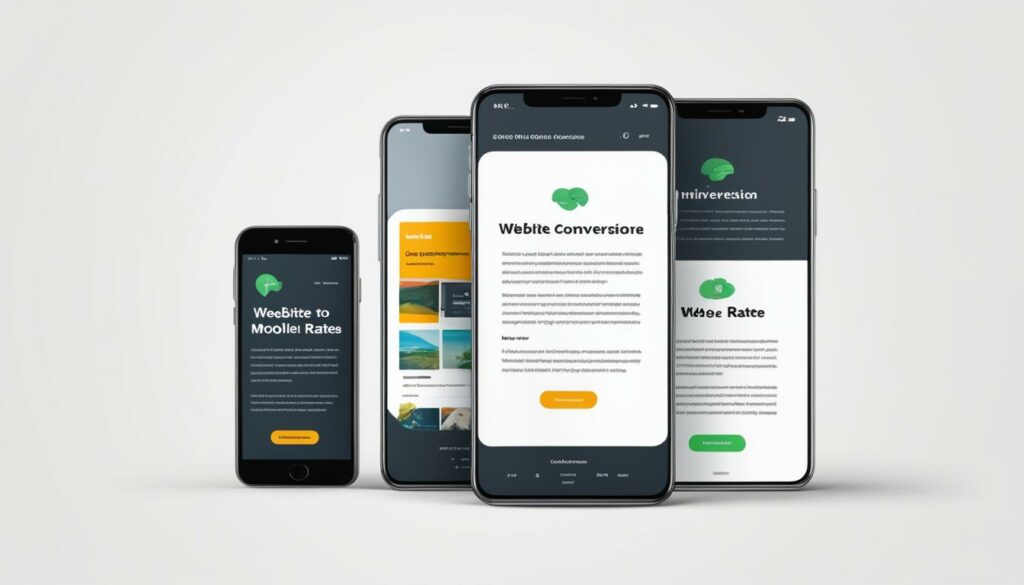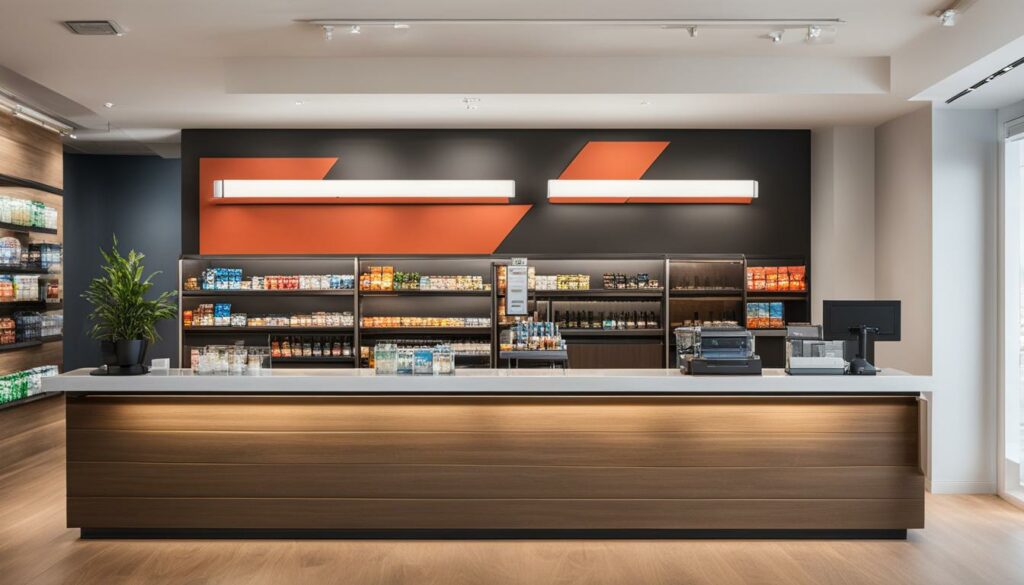Looking to increase conversions on your WooCommerce product pages? Optimizing conversions is essential for driving sales and maximizing the success of your online store. By implementing effective strategies and best practices, you can optimize your WooCommerce sales and improve your conversion rates.
Understanding your conversion rates is the first step towards optimization. By tracking your conversions and setting realistic goals, you can assess your performance and identify areas for improvement. Tools like Google Analytics provide valuable insights into your conversion rate, allowing you to analyze factors that influence your conversions:
- Industry: Different industries have varying conversion rates, so it’s crucial to compare your rates with industry benchmarks.
- Price: The pricing of your products can influence conversion rates. Monitoring how price changes impact conversions can help you find the optimal pricing strategy.
- Brand: Building trust and credibility through your brand can positively impact conversion rates. Consistency in branding and messaging can lead to higher conversions.
- Traffic Source: Analyzing the source of your traffic can help you understand which channels are driving the most conversions. This allows you to allocate your marketing efforts strategically.
Once you have a clear understanding of your conversion rates, it’s time to implement strategies to boost your WooCommerce product page conversions. Here are some key tactics to consider:
Key Takeaways:
- Track your conversion rates using tools like Google Analytics to understand your performance and identify opportunities for improvement.
- Personalize the user experience by segmenting your audience, optimizing for mobile devices, and improving the user interface.
- Collect and showcase customer reviews to build trust and credibility.
- Simplify the checkout process to minimize cart abandonment rates.
- Optimize your product pages for SEO to drive organic traffic and increase conversions.
Understanding Conversion Rates in Ecommerce
Conversion rates play a crucial role in determining the success of your online store. In ecommerce, a conversion rate refers to the percentage of website visitors who take a desired action, such as making a purchase or subscribing to a newsletter. However, it’s important to note that having a high volume of website traffic doesn’t automatically translate into high conversion rates.
Multiple factors can influence the conversion rates on your ecommerce site. Let’s explore some of the key elements that impact how visitors interact with your online store:
- User Experience: The overall experience users have while navigating your website can greatly affect their likelihood of converting. Factors such as clear and intuitive site navigation, fast-loading pages, appealing design, and user-friendly interfaces all contribute to a positive user experience.
- Product Presentation: How you showcase and describe your products significantly impacts conversions. High-quality product images, detailed and accurate descriptions, and customer reviews can help build trust and make visitors more likely to purchase.
- Ease of Navigation: If your visitors struggle to find what they’re looking for or encounter barriers during the shopping process, they may abandon their purchase. Optimizing your website for easy navigation, clear product categories, and search functionality can improve conversion rates.
- Trust Factors: Building trust with your audience is crucial for conversions. Displaying trust badges, security certifications, customer testimonials, and clear return policies can instill confidence and reduce hesitation in making a purchase.
- Promotions and Incentives: Offering discounts, limited-time deals, free shipping, or other promotional incentives can create a sense of urgency and motivate visitors to convert.
By analyzing your conversion rates and understanding the factors that influence them, you can optimize your ecommerce store for higher conversion rates. Implementing strategies to improve user experience, product presentation, navigation, trust factors, and promotions can all contribute to increased conversions.
Tracking and measuring conversion rates is vital to monitor the effectiveness of these strategies. Let’s explore some effective methods for tracking and analyzing conversion rates in the next section.
Tips for Personalizing the User Experience
Personalization plays a crucial role in ecommerce, especially when it comes to improving user engagement and increasing conversions on your WooCommerce store. By providing a personalized user experience, you can enhance customer satisfaction and drive sales. Here are some effective tips for personalizing the user experience:
Segment your Audience
Segmenting your audience based on factors like location and language is a powerful way to create personalized experiences. By tailoring your content and offers to specific segments, you can better meet the needs and preferences of your customers. Consider using translation plugins to provide content in different languages and implementing dynamic tags to customize your messaging.
Utilize Email Marketing
Email marketing is a valuable tool for engaging users and encouraging conversions. By sending personalized emails with relevant product recommendations or exclusive offers, you can effectively re-engage users and drive them back to your store. Additionally, automated abandoned cart reminders can help recover lost sales and improve conversion rates.
Optimize for Mobile Devices
In today’s mobile-dominated world, optimizing your online store for mobile devices is essential. Ensure that your website has a responsive design, meaning it adapts seamlessly to different screen sizes. This will provide a consistent and user-friendly experience for mobile shoppers, ultimately increasing conversions.
Offer a Seamless User Interface
Creating a seamless user interface is crucial for enhancing the overall user experience. Simplify navigation, improve website speed, and make the purchasing process as smooth as possible. Intuitive design and easy-to-use features will keep users engaged and encourage them to convert.
Implementing these tips will help you create a personalized user experience that improves engagement and drives conversions on your WooCommerce store.
The Importance of Mobile Optimization
Mobile optimization is essential to boost your WooCommerce conversion rates and improve the performance of your online store. With a significant number of sales happening on mobile devices, it’s crucial to ensure that your website is responsive and mobile-friendly.
Testing the user interface on various mobile devices will help you identify any issues and make necessary improvements. Optimize your website speed to provide a seamless browsing experience for mobile users. Additionally, simplify the navigation to make it easier for customers to find what they’re looking for.
By prioritizing mobile optimization and creating a mobile-friendly shopping experience, you can increase conversions on mobile devices and maximize your WooCommerce sales.

Key Benefits of Mobile Optimization:
- Improved User Experience: Mobile optimization ensures that your website is easy to navigate, loads quickly, and provides a smooth browsing experience on mobile devices.
- Increased Conversion Rates: By optimizing for mobile, you cater to a large portion of your audience, leading to higher conversion rates and more sales.
- Better Search Engine Visibility: Mobile-friendly websites are favored by search engines and are more likely to rank higher in mobile search results.
Mobile Optimization Best Practices:
- Responsive Design: Use a responsive design that adapts to different screen sizes and ensures optimal viewing on mobile devices.
- Fast Loading Speed: Optimize your website speed to reduce loading times on mobile devices.
- Clear and Intuitive Navigation: Simplify the navigation menu and ensure that it is easy for users to find what they’re looking for.
- Mobile-Friendly Checkout Process: Streamline the checkout process for mobile users to minimize friction and cart abandonment.
Mobile Optimization Statistics:
| Statistic | Mobile Conversion Rates |
|---|---|
| Percentage of sales from mobile devices | 55% |
| Global mobile internet traffic | 54.8% |
| Mobile conversion rate compared to desktop | 60% lower |
By implementing mobile optimization strategies, you can tap into the growing mobile market and improve your WooCommerce conversion rates. Ensure that your website is responsive, fast, and user-friendly, catering to the needs of mobile users. By providing a seamless mobile shopping experience, you will drive more conversions and increase your sales.
Enhancing the User Interface for Higher Conversions
The user interface (UI) plays a vital role in driving conversions on WooCommerce product pages. By optimizing the user interface and making it visually appealing, you can significantly improve your chances of converting visitors into customers. Here are a few key strategies to enhance the user interface and boost conversions:
- Optimize Call-to-Action Buttons: Ensure that your call-to-action buttons are visually appealing and clearly visible. Choose contrasting colors that make them stand out on the page. Additionally, strategic placement of these buttons can encourage users to take the desired action.
- Focus on Visual Changes: Clear and fast-loading product images can help users visualize the product and make informed purchase decisions. Seamless navigation and intuitive user flows contribute to a positive user experience. Remember, the more visually appealing your website is, the higher the likelihood of conversions.
- Utilize Tools and Conduct A/B Testing: Tools like Hotjar allow you to gather user insights, behavior, and click patterns. Conducting A/B testing helps you compare different designs and layouts to identify the most effective user interface elements. Additionally, page builders like Elementor offer clean and functional designs that enhance the user interface and drive conversions.
User Interface Optimization Strategies
Here is a visual summary of the user interface optimization strategies:
| Optimization Strategies | Benefits |
|---|---|
| Optimize call-to-action buttons | Increase user engagement and encourage conversions |
| Focus on visual changes | Influence purchase decisions and enhance the user experience |
| Utilize tools and conduct A/B testing | Gather user insights, behavior, and compare different designs for optimization |
By implementing these strategies, you can optimize the user interface of your WooCommerce store and improve conversion rates. Remember, a visually appealing and user-friendly interface will create a positive experience for your visitors, leading to higher conversions.
Harnessing the Power of Customer Reviews
Customer reviews play a pivotal role in driving conversions on your WooCommerce product pages. Positive reviews and ratings have the power to build trust and credibility, ultimately leading to higher conversion rates. By leveraging the impact of social proof through customer reviews, you can significantly enhance the likelihood of potential customers making a purchase.
One effective way to incorporate customer reviews into your WooCommerce store is by implementing plugins like Customer Reviews for WooCommerce. This enables your customers to review their purchases and provide valuable feedback, further strengthening the authenticity and transparency of your brand. Encouraging satisfied customers to leave reviews through follow-up emails can help increase the number of reviews and contribute to a positive online reputation.
However, it is imperative to manage customer reviews ethically and honestly. Authenticity should always be prioritized, and it is crucial not to manipulate reviews. Genuine customer feedback is pivotal in establishing trust with potential customers and should not be compromised. Displaying customer reviews prominently on your product pages allows visitors to see real experiences and opinions, reinforcing the credibility of your offerings.
Why are customer reviews important for conversions?
Customer reviews serve as a powerful form of social proof that influences purchasing decisions. When potential customers see positive reviews from real people who have used and enjoyed your products, they are more likely to trust your brand and convert.
“I purchased a pair of running shoes based on the positive reviews, and they exceeded my expectations! The reviews definitely helped me make the decision to buy.”
– Emma Thompson
Additionally, customer reviews provide valuable insights into the benefits, features, and overall quality of your products. They address common concerns or questions that potential customers may have, making it easier for them to make an informed buying decision.
Implementing customer reviews effectively
To harness the power of customer reviews and maximize their impact on conversions, consider the following best practices:
- Make customer reviews easily accessible on your product pages, ideally near the top or alongside key product information.
- Include a star rating system that visually represents the overall customer satisfaction.
- Encourage customers to share not only positive but also constructive feedback, providing a balanced perspective on your products.
- Respond to customer reviews, both positive and negative, to show your dedication to customer satisfaction and address any concerns publicly.
- Regularly monitor and moderate customer reviews to ensure their authenticity and filter out any spam.
By effectively managing and leveraging customer reviews, you can build trust, inspire confidence, and ultimately increase conversions on your WooCommerce store.
Now that we’ve explored the power of customer reviews, let’s move on to Section 7, where we will discuss how to streamline the checkout process for higher conversions.
| Benefits of Customer Reviews for Conversions | Impact on Conversion Rates | Strategies for Managing Customer Reviews |
|---|---|---|
| Builds trust and credibility | Higher conversion rates | Implement customer review plugins |
| Provides social proof | Influences purchasing decisions | Encourage satisfied customers to leave reviews through follow-up emails |
| Addresses potential customer concerns | Enhances customer engagement | Display customer reviews prominently on product pages |
Streamlining the Checkout Process for Higher Conversions
The checkout process on your WooCommerce product pages plays a crucial role in driving conversions. To optimize your conversion rates and reduce cart abandonment, it’s essential to streamline the checkout process and provide a seamless experience for your customers.
Here are some strategies to help you optimize the checkout process:
- Offer Guest Checkout Options: Many customers prefer a quick and hassle-free checkout experience. By allowing guest checkout, you eliminate the need for customers to create an account, reducing friction and increasing conversions.
- Minimize the Number of Steps: Lengthy and complicated checkout processes can lead to cart abandonment. Simplify the process by minimizing the number of steps and optimizing the order of information input.
- Multiple Payment Options: Provide customers with a variety of payment options to cater to their preferences. Offering options like credit card payments, PayPal, and digital wallets improves convenience and encourages completed purchases.
- Transparent Shipping Costs: Clearly state shipping costs upfront, so customers are aware of the total cost before proceeding to checkout. Hidden fees or unexpected costs can lead to cart abandonment.
- Secure and Trustworthy Payment Gateway: Ensure that your online store uses a reliable and secure payment gateway. Display trust seals and security badges to instill confidence in your customers.
Implementing these strategies will help optimize your checkout process and increase conversions on your WooCommerce product pages.
| Checkout Optimization Strategies | Benefits |
|---|---|
| Offering guest checkout options | – Reduces friction – Increases conversions |
| Minimizing the number of steps | – Simplifies the process – Decreases cart abandonment |
| Providing multiple payment options | – Improves convenience – Appeals to different customer preferences |
| Transparently stating shipping costs | – Avoids surprises – Enhances trust |
| Using a secure payment gateway | – Instills confidence – Protects customer data |
Streamlining the checkout process is vital for reducing cart abandonment and increasing conversions. By implementing guest checkout options, minimizing steps, offering multiple payment options, transparently stating shipping costs, and ensuring a secure payment gateway, you can optimize the checkout experience and drive higher conversion rates.

SEO Optimization for Better Conversions
SEO optimization plays a crucial role in improving conversions on your WooCommerce product pages. By implementing effective SEO strategies, you can increase search engine visibility, drive organic traffic, and ultimately boost conversions. Here are some key areas to focus on for better SEO optimization:
1. Metadata Optimization
Optimizing metadata is essential for improving your product page’s visibility in search engine results. Include relevant keywords in your title tags, meta descriptions, and header tags to help search engines understand the content and relevance of your pages. Craft concise and compelling meta descriptions that entice users to click through to your product pages.
2. Image Optimization
Image optimization is a critical aspect of SEO. By reducing image file size and including descriptive alt tags, you can improve page load speed and enhance user experience. Optimized images not only contribute to better SEO but also make your product pages visually appealing and engaging. Use the following code to optimize your images:
3. Website Structure
A well-structured website with clear navigation and user-friendly features is essential for SEO optimization. Implement breadcrumbs and a search bar to improve user experience and help search engines understand your site’s structure. Consider using SEO plugins that offer additional features to enhance your website’s structure and navigation.
4. Content Optimization
Optimize your product page content by incorporating relevant keywords naturally within your product descriptions, headings, and body text. Ensure that your content provides valuable information to potential customers and is unique and engaging. Remember, high-quality and informative content can be a driving force behind user engagement and conversions.
5. Mobile Optimization
With the increasing use of mobile devices for online shopping, mobile optimization is crucial. Ensure that your WooCommerce store is responsive, with a design that adapts seamlessly to various screen sizes. Test the user interface on different mobile devices to ensure a smooth and intuitive browsing experience for mobile users.
By paying attention to these important SEO optimization practices, you can improve your WooCommerce product pages’ visibility, attract more targeted traffic, and increase conversions. Remember to regularly analyze your SEO efforts, monitor your website’s performance using tools like Google Analytics, and make data-driven optimizations to continuously improve your conversion rates.
Creating a Sense of Urgency and Promotions
Creating a sense of urgency and offering promotions can significantly impact conversions on your WooCommerce product pages. By leveraging psychological triggers and implementing strategic promotional tactics, you can effectively increase sales and boost conversions.
One effective strategy is to offer limited-time offers. By setting a deadline for exclusive deals or discounts, you create a fear of missing out (FOMO) and urge users to make a purchase sooner rather than later. To enhance this sense of urgency, consider implementing countdown timers on your product pages, highlighting the time remaining for the offer.
Discount codes are another powerful tool for driving conversions. By offering special promo codes or coupon discounts, you incentivize customers to complete their purchases. You can actively promote these codes through popups, banners, and email marketing campaigns, ensuring that customers are aware of the exclusive savings they can take advantage of.
Psychological Triggers for Conversions
Understanding the psychological triggers that drive conversions can help you craft compelling promotional messages. Some effective triggers include:
- Scarcity: Highlighting limited quantities or availability of a product can create a sense of urgency and encourage customers to take immediate action.
- Social Proof: Showcasing testimonials, reviews, or endorsements from satisfied customers can build trust and credibility, making it more likely for potential buyers to convert.
- Exclusivity: Offering exclusive access to certain products, discounts, or rewards can make customers feel special and increase their willingness to make a purchase.
- Authority: Positioning your brand or products as industry leaders or experts can instill confidence in potential customers and drive conversions.
When implementing promotional incentives, it’s important to strike a balance and avoid overwhelming customers with excessive promotional content. By providing strategic offers, personalized to the customer’s preferences or purchase history, you can enhance the effectiveness of your promotions and drive conversions.
Implementing a visually appealing and relevant image can catch your readers’ attention while reinforcing the idea of creating urgency for conversions.
By leveraging the power of promotional incentives, limited-time offers, and psychological triggers, you can effectively increase conversions on your WooCommerce product pages. Experiment with different tactics, analyze the results, and continuously refine your promotional strategies to optimize your conversion rates and drive more sales.
Tracking and Analyzing Conversion Rates
To optimize your WooCommerce product pages, it’s crucial to track and analyze your conversion rates. By understanding how your customers behave and interact with your website, you can make data-driven decisions to improve your conversion performance. One of the most valuable tools for tracking and analyzing conversion rates is Google Analytics.
Google Analytics provides insightful data on user behavior, conversion funnels, and overall website performance. By setting up goals and tracking conversion rates for different segments and goals, you can identify areas for improvement. For example, you can track the conversion rates for different traffic sources, demographic groups, or device types to gain a deeper understanding of your audience and make targeted optimizations.
Moreover, conducting A/B tests can help you compare different versions of your website and measure their impact on conversion rates. By testing different elements such as page layouts, call-to-action buttons, or product descriptions, you can optimize the user experience and increase conversions. A/B testing allows you to make data-driven decisions and implement changes that have a positive effect on your conversion rates.
By utilizing analytics and testing tools like Google Analytics and A/B testing, you can gain valuable insights into your WooCommerce store’s performance. Tracking conversion rates and analyzing ecommerce metrics empowers you to understand your customers better and make informed decisions to optimize your product pages for higher conversions.
Implementing Strategies for Optimal Conversion Rates
Implementing strategies to optimize conversion rates is a continuous process. It involves experimenting with different tactics, analyzing data, and making iterative improvements. By implementing effective conversion rate strategies, you can optimize the performance of your ecommerce website and drive continuous improvement for conversions.
- Personalizing the user experience: Tailor your website to the preferences and needs of your target audience. Use personalized product recommendations, dynamic content, and targeted messaging to create a unique experience for each visitor.
- Optimizing for mobile devices: With the increasing use of smartphones for online shopping, make sure your website is mobile-friendly and responsive. Optimize page load times, improve navigation, and ensure a seamless mobile shopping experience.
- Enhancing the user interface: Design an intuitive and visually appealing user interface. Optimize the placement and design of call-to-action buttons, simplify the navigation, and use persuasive product descriptions and imagery to engage your customers.
- Showcasing customer reviews: Highlight customer reviews and ratings on your product pages. Social proof can greatly influence buying decisions and increase trust in your brand.
- Streamlining the checkout process: Simplify the checkout process to minimize friction and reduce cart abandonment. Offer guest checkout options, provide multiple payment methods, and clearly display shipping costs and return policies.
- Optimizing for SEO: Improve the visibility of your ecommerce website in search engine results by optimizing your product pages’ metadata, incorporating relevant keywords, and improving your website’s overall SEO performance.
- Creating a sense of urgency: Use limited-time offers, special promotions, and countdown timers to create a sense of urgency and encourage immediate action from your customers.
- Tracking conversion rates: Continuously monitor and analyze your conversion rates using tools like Google Analytics. Identify areas of improvement and make data-driven decisions to optimize your conversion rate strategies.
By implementing these strategies, you can effectively optimize your ecommerce performance, drive higher conversion rates, and achieve continuous improvement for conversions.
The Impact of Conversion Rate Optimization
“Conversion rate optimization is not just about increasing the number of conversions but also about increasing the value that each conversion brings. It’s about maximizing the revenue generated from your ecommerce store.”
Implementing conversion rate optimization strategies can result in significant improvements in your ecommerce performance. By optimizing your website for conversions, you can attract more qualified traffic, increase customer trust, and encourage more visitors to take action and make a purchase. Continuous improvement for conversions ensures that your ecommerce business stays competitive in a constantly evolving online marketplace.
Example Conversion Rate Optimization Results
Here is an example table showcasing the impact of conversion rate optimization strategies:
| Key Metric | Before Optimization (%) | After Optimization (%) | Improvement (%) |
|---|---|---|---|
| Conversion Rate | 2.5 | 4.5 | 80 |
| Average Order Value | $50 | $70 | 40 |
| Total Revenue | $10,000 | $20,250 | 102.5 |
As shown in the example above, implementing conversion rate optimization strategies can lead to a significant increase in conversion rates, average order value, and total revenue. These improvements demonstrate the potential impact of optimizing your ecommerce performance and continuously improving your conversions.
Conclusion
Optimizing conversions on your WooCommerce product pages is crucial for increasing sales and driving the success of your online store. By implementing best practices for conversion rate optimization, you can effectively improve conversions and boost sales.
To start, it’s essential to understand your conversion rates and set realistic goals. By tracking and analyzing your conversion rates using tools like Google Analytics, you can identify areas for improvement and make data-driven decisions.
Personalizing the user experience, optimizing for mobile devices, enhancing the user interface, leveraging customer reviews, streamlining the checkout process, optimizing for SEO, creating a sense of urgency, and tracking conversion rates are all key strategies to consider.
By continuously implementing these best practices and striving for optimization, your WooCommerce store will thrive and achieve optimal conversion rates, resulting in increased sales and growth for your business. Best of luck!
FAQ
What is the importance of optimizing conversions on WooCommerce product pages?
Optimizing conversions on WooCommerce product pages is essential for increasing sales and driving the success of your online store. By improving your conversion rates, you can maximize the number of visitors who make a purchase, leading to increased revenue.
How can I track my conversion rate on WooCommerce?
You can track your conversion rate on WooCommerce using Google Analytics. It allows you to measure the number of conversions divided by the number of sessions, giving you valuable insights into how well your product pages are converting visitors into customers.
What factors can influence my conversion rate on WooCommerce?
Several factors can influence your conversion rate on WooCommerce, including your industry, product price, brand reputation, and traffic sources. Understanding these factors can help you identify areas for improvement and implement strategies to boost your conversion rate.
How can I personalize the user experience on my WooCommerce store?
You can personalize the user experience on your WooCommerce store by segmenting your audience based on location and language, using translation plugins, and implementing dynamic tags. You can also utilize email marketing and automated abandoned cart reminders to personalize the content and offers for your users.
Why is mobile optimization important for WooCommerce conversions?
Mobile optimization is crucial for WooCommerce conversions because a significant percentage of sales comes from mobile devices. By ensuring that your online store is responsive and mobile-friendly, you can provide a seamless shopping experience for mobile users and increase your conversion rates.
How can I enhance the user interface on my WooCommerce product pages?
To enhance the user interface on your WooCommerce product pages, you can optimize the call-to-action buttons, improve product image quality and loading speed, and ensure a clean and functional design. Implementing tools like Hotjar and conducting A/B testing can further optimize the UI and improve conversions.
How can customer reviews impact conversions on WooCommerce?
Customer reviews have a significant impact on conversions as they provide social proof and build trust with potential customers. By implementing customer review plugins and showcasing positive reviews prominently on your product pages, you can increase conversions and persuade visitors to make a purchase.
What can I do to streamline the checkout process for higher conversions?
To streamline the checkout process for higher conversions on WooCommerce, you can offer guest checkout options, simplify the number of steps required, and provide multiple payment options. Minimizing cart abandonment rates and ensuring a secure and trustworthy payment gateway are also crucial for improving the checkout experience.
How can I optimize my WooCommerce product pages for SEO?
To optimize your WooCommerce product pages for SEO, you can focus on optimizing metadata, including relevant keywords and concise product descriptions. Image optimization, including alt tags and file size reduction, can also improve page load speed and user experience. Utilizing SEO plugins and tools like breadcrumbs and search bars can further optimize your website’s structure and user navigation.
How can I create a sense of urgency and offer promotions to increase conversions?
Creating a sense of urgency and offering promotions can significantly impact conversions on WooCommerce product pages. Limited-time offers, discount codes, and countdown timers can create a fear of missing out (FOMO) and urge users to make a purchase. Implementing popups, banners, and email marketing campaigns featuring exclusive deals and discounts can further drive conversions.
How can I track and analyze conversion rates on my WooCommerce store?
You can track and analyze conversion rates on your WooCommerce store using tools like Google Analytics. It provides valuable insights into user behavior, conversion funnels, and performance metrics. By tracking conversion rates for different goals and segments and conducting A/B tests, you can optimize the user experience and improve your conversion performance.
What are some strategies for optimizing conversion rates on WooCommerce?
To optimize conversion rates on WooCommerce, you can focus on personalizing the user experience, optimizing for mobile devices, enhancing the user interface, showcasing customer reviews, streamlining the checkout process, optimizing for SEO, creating a sense of urgency, and tracking conversion rates. Implementing these strategies and continuously improving will help you achieve optimal conversion rates and increase sales on your WooCommerce store.












